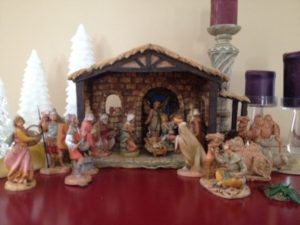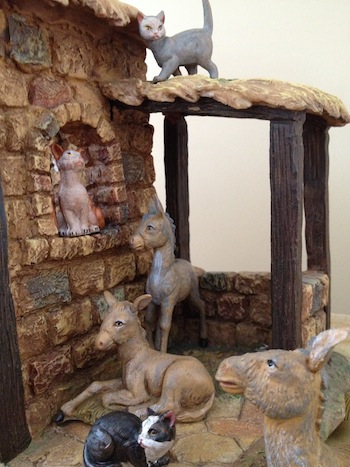The Hebgen Lake Earthquake of 1959 struck on a moonlit August night in western Montana,…
What animals belong in the Creche?


Given my interest in Biblical history, it’s no surprise that Christmas decorating at my house includes a lot of nativity scenes. We have plenty of candles, sparkling ornaments, and candy canes, but nativity scenes are my favorite and at last count, we had eight sets. In one of my favorite Christmas traditions, my kids buy me a new figure each year to add to my Fontanini nativity. Of course, their favorite pieces to give are the animals. So far, I have donkeys, sheep, camels, oxen, chickens, and cats.
That cats are what started me thinking. Were there really cats in ancient Judea? With a little research, it was easy to find out what kinds of domesticated animals could have shared the manger with Jesus.
And there were shepherds living out in the fields nearby, keeping watch over their flocks at night. Luke 2:8
Sheep, of course, were vital to the people of the Holy Land. The breed that was likely common at the time was the fat-tailed Barbary sheep, with a thick, fatty tail that weighed more than 20 pounds.
Goats, as well, were one of the principle animal resources of the land as we can see from the important parts they play in the parables and metaphors of the Bible. Both sheep and goats were invaluable for their milk, meat, wool, and skins.
Cows were less common, but not unknown. The red heifer was a symbol of purity, and its ashes were used in the Jewish purity rituals after burial of their dead. Oxen were mentioned often in terms of plowing and sacrifice.
Although the Christmas narrative in Luke doesn’t say that Mary rode to Bethlehem on a donkey, it is likely. The donkey, or ass, was important to almost every family. This was not the small, cute donkey often seen in nativity scenes, but a large, strong animal that could cover 25 miles a day on a journey to Jerusalem.
The horse, on the other hand, wasn’t as useful or as common. The only horseman that a first century Israelite would have seen were Roman soldiers. (I have a Roman soldier in my nativity, and I’ve named him Longinus after my hero in The Theif.)
The camel, often in nativity scenes, was also rare. It cost a great deal but could carry a heavy load for more than thirty miles. It would have been used mostly by traders coming from the east and so we often see them beside the wise men at the manger scene. At our house, we leave the wise men and their camels across the room, and let them journey day by day to the manger. They arrive on Epiphany, which gives me a great excuse to leave my Christmas decorations up well into January.
Poultry would have been common, even right in the city of Jerusalem or in Bethlehem. Chickens, pigeons, ducks and geese were raised for their meat and eggs in many households.
Dogs are mentioned over forty times in the Bible, but they weren’t man’s best friend in those days. Instead they were a bad-tempered mixture of jackal and wolf, roaming the streets as scavengers.
Pigs were unclean and only belonged to pagans. I’ll have no pigs in my nativity scene.
Domestic cats, although revered in Egypt, were rare in Judea, and there is no word for a feline friend in ancient Hebrew. I like my little cats in my nativity, though, so I’ll be leaving them even if they are historically inaccurate.
Do you have a favorite nativity scene or Christmas tradition at your house? Share it with me!
Tweet this: What animals belong in the #Christmas story? http://www.stephanielandsem.com/?p=1126
Tweet this: #Cats in the #Christmas creche? Not likely. http://www.stephanielandsem.com/?p=1126
